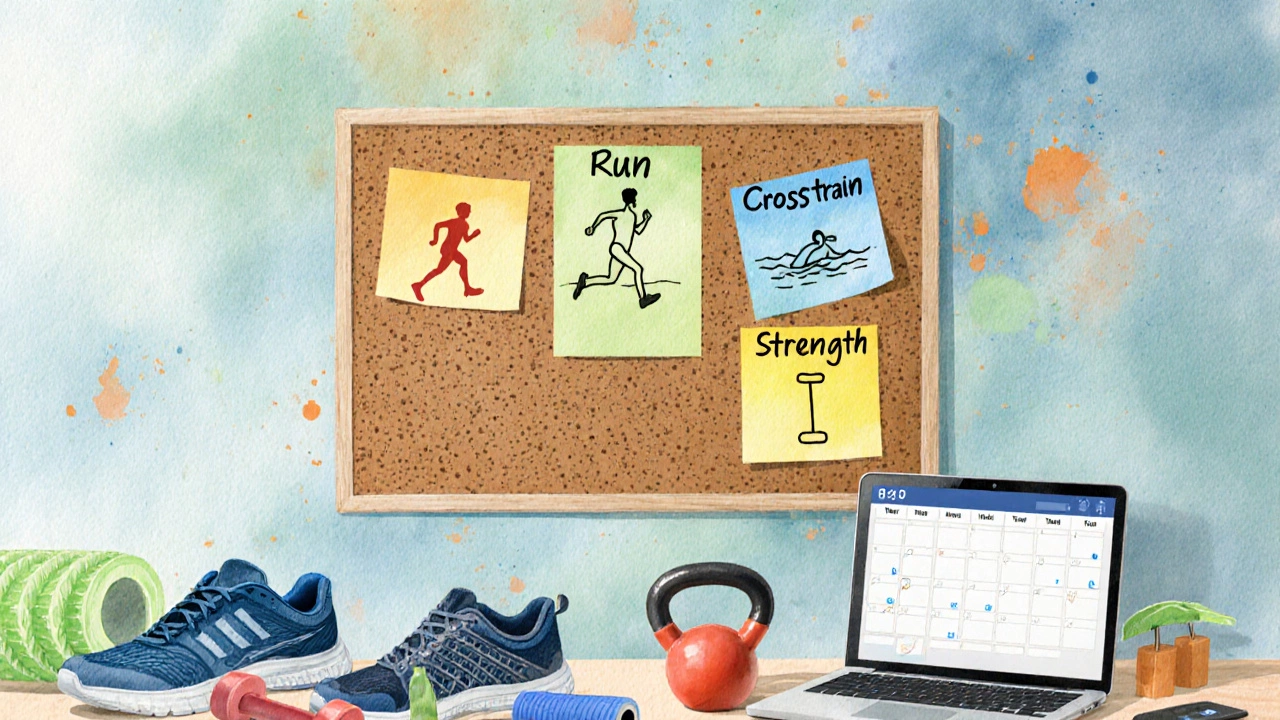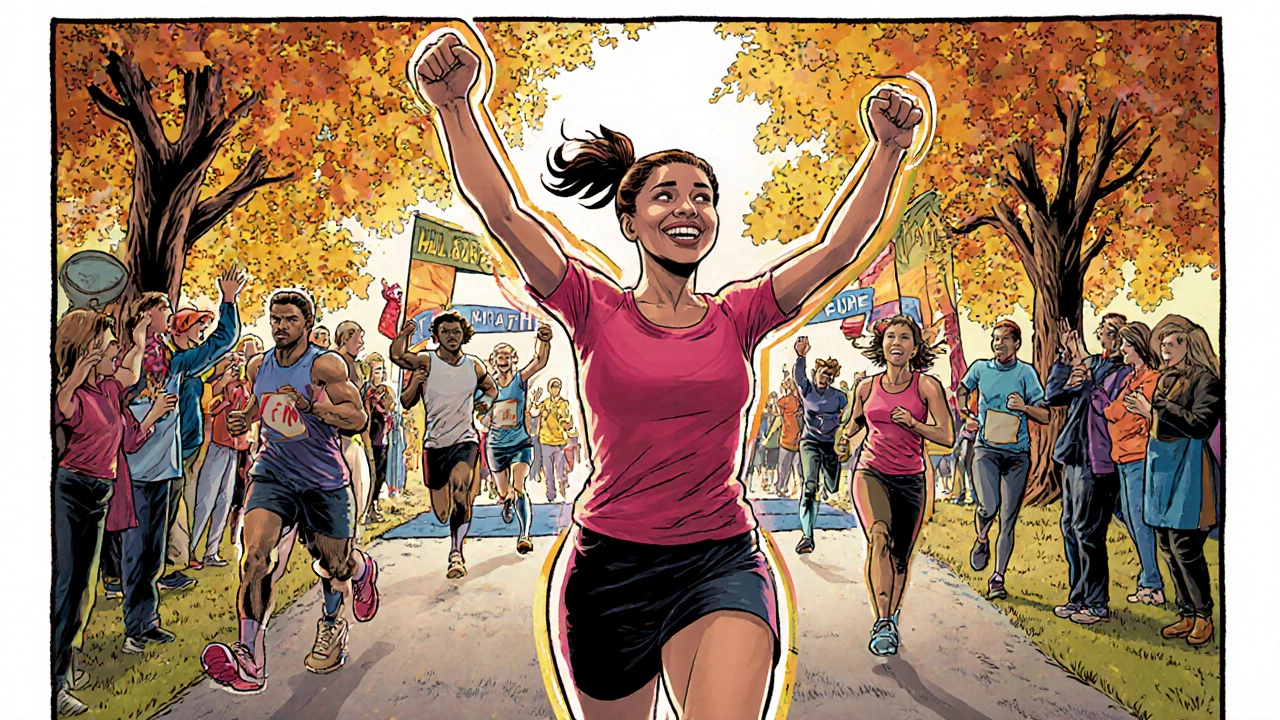Starting Running at 37: Is It Too Late?
 Oct, 15 2025
Oct, 15 2025
Safe Running Mileage Calculator
Calculate Your Safe Progression
Weekly Mileage Progression
| Week | Mileage (miles) | Notes |
|---|---|---|
| Enter your current and target mileage to see your safe progression | ||
10% Rule Reminder: The American College of Sports Medicine recommends increasing weekly mileage by no more than 10% to prevent injuries. This calculator follows this guideline for safe progression.
Quick Takeaways
- Age 37 is well within the window for a healthy start to running.
- Focus on gradual mileage, proper recovery, and strength work.
- Know your health baseline - a quick check‑up can spot hidden issues.
- Use a balanced training plan that mixes easy runs, interval work, and cross‑training.
- Gear matters - invest in shoes that suit your foot type and running style.
Wondering if 37 is too old to lace up your shoes? The short answer: no. The longer answer is that you’ll need a smart, body‑friendly approach. Below we break down the science, the worries most beginners have, and a step‑by‑step starter plan that works for anyone in their late‑30s.
Why Age 37 Isn’t a Barrier
When you hear the phrase “peak performance,” you might picture 20‑year‑old sprinters. But Running is a low‑impact aerobic activity that can be started at virtually any adult age and still deliver major health gains. A 2023 study from the American College of Sports Medicine showed that adults who begin regular running after 35 improve their Cardiovascular health by lowering resting heart rate and increasing stroke volume within six months.
Even the metric most runners obsess over - VO2 max the maximum amount of oxygen your body can use during intense exercise - rises by an average of 10‑15% in new runners aged 35‑45, according to a 2022 European Journal of Applied Physiology paper. Those gains translate into better endurance, more energy for daily tasks, and a lower risk of heart disease.
Common Concerns for New Runners Over 35
Most people who think about starting at 37 mention three worries:
- Injuries, especially to knees and hips.
- Longer recovery times.
- Whether they’ll ever be able to finish a marathon.
Let’s tackle each one.
Injury risk isn’t a magic number; it’s about preparation. As you age, Joint health can be affected by previous wear and tear, but strengthening the surrounding muscles dramatically reduces the odds of trouble. A 2021 review in Sports Medicine found that runners who added two weekly strength sessions cut injury rates by 30%.
Recovery does get a bit slower after 30, but you can outrun that slowdown with proper sleep, nutrition, and Recovery planned rest days, compression, and foam‑rolling to aid muscle repair. Aim for at least one full rest day per week and use active recovery (light cycling, swimming) on the other “easy” days.
Finally, the marathon question. Marathon training a structured program that builds mileage safely over 16‑20 weeks is achievable at 37, especially if you honor the 10‑percent rule (increase weekly mileage by no more than 10% each week). Many clubs report first‑time marathoners in their late‑30s who hit the wall just once - and that wall was mostly mental.

Building a Safe Starter Plan
Here’s a 12‑week blueprint that gets you comfortable running three times a week while protecting your joints.
- Medical check‑up: Get a basic health screen (blood pressure, cholesterol, resting ECG if you have a family history of heart issues).
- Get the right shoes: Visit a specialty store, get a gait analysis, and pick shoes with adequate cushioning for your foot strike.
- Week 1‑4 - Foundation:
- Run 2‑3 days, 20‑30 minutes at a conversational pace.
- Include 1 day of Cross‑training low‑impact activities like swimming or cycling to build aerobic base.
- Add two 15‑minute strength sessions focusing on core, glutes, and calves.
- Week 5‑8 - Add Intensity:
- Introduce one “tempo” run: 10 minutes easy, 10 minutes at a comfortably hard pace, 5 minutes cool down.
- Increase one long run by 5 minutes each week, keeping the pace easy.
- Continue strength work, now adding single‑leg exercises (lunges, step‑ups).
- Week 9‑12 - Build Endurance:
- Two runs per week stay at 30‑45 minutes, one day becomes a “steady‑state” run of 60 minutes.
- Long run reaches 90 minutes by week 12; this is the longest you'll go before any marathon plan.
- Maintain a recovery day after each hard effort.
Notice the emphasis on Strength training targeted work for hips, core, and legs to protect joints and improve running economy. The “once‑a‑week” strength day can be done with bodyweight or light dumbbells - the key is consistency.
Training for a Marathon: What Changes After 35
If you decide to go from 5K to 26.2 miles, the core structure stays the same, but a few tweaks help the 30‑plus body.
- Long runs become more gradual. Add 5‑10 minutes every two weeks instead of weekly spikes.
- Include a cut‑back week. Every fourth week drop mileage by 20‑30% to let the body adapt.
- Prioritize sleep. Aim for 7‑9 hours; research links Heart rate variability improvements to deeper sleep, which in turn boosts endurance.
- Nutrition tweaks. Slightly higher protein (1.2‑1.4g/kg) supports muscle repair, especially after the longer runs.
- Regular mobility work. Dynamic stretches before runs and static holds after help maintain joint range of motion.
All of these adjustments keep the cumulative stress manageable, meaning you won’t “burn out” before race day.

Gear and Recovery Tips for Late Starters
Gear isn’t about flashy colors; it’s about function.
| Benefit | Running | Walking |
|---|---|---|
| Cardio improvement | Higher VO2 max gains (10‑15% in 6 months) | Modest improvements, slower progress |
| Calorie burn | ~100 kcal per mile | ~50 kcal per mile |
| Joint impact | Low‑impact if cadence > 170 spm | Very low impact |
| Time efficiency | More mileage in less time | Longer sessions for same cardio benefit |
Invest in a pair of shoes with good arch support and responsive cushioning - the right pair can cut joint stress by up to 30% (a finding from a 2020 Footwear Biomechanics study). Consider a lightweight GPS watch to monitor Heart rate real‑time zones that help you stay in aerobic or threshold zones.
Recovery tools matter too: foam rollers, compression socks, and a simple routine of leg swings and hip openers after each run speed up muscle repair and keep you flexible.
Real‑World Example: A Sydney Runner Who Started at 37
Meet Maya, a 37‑year‑old graphic designer from Bondi. She hadn’t run since high school, but after a routine health check she decided to try a beginner’s 10‑week plan. Within three months she completed a 10K, and by month six she was training for a half‑marathon. She credits her success to three things:
- Consistent strength work (bodyweight squats, planks).
- Listening to her body - she backed off when sore, not pushing through pain.
- Using a local running club for accountability and free group runs.
Maya’s story shows that age 37 is not a stop sign; it’s just a different starting line.
Frequently Asked Questions
Can I start running if I’ve never exercised before?
Yes. Begin with short, easy jog‑walk intervals (e.g., 1minute run, 2minutes walk) and progressively increase the run portion. The key is consistency, not speed.
Do I need a doctor’s clearance at 37?
If you have any known heart issues, hypertension, or a family history of cardiovascular disease, a quick physical exam is wise. Otherwise, most healthy adults can start safely with a gradual plan.
How many days a week should I run?
Three days is ideal for beginners over 35. One day can be a longer, slower run, another a moderate‑pace run, and the third an easy recovery run.
Will I lose my knees?
Running does not automatically damage knees. Proper footwear, good running form, and regular strength work for the hips and glutes protect the knee joint.
How long before I can run a marathon?
Most first‑time marathoners need 16‑20 weeks of specific training after they’re comfortable running 30‑40km per week. Starting at 37 simply means you may need a few extra recovery weeks.